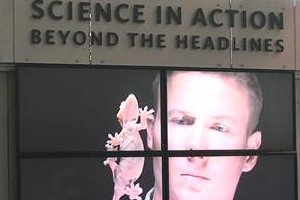 The California Academy of Sciences was a representative at the Copenhagen conference on climate change.
The California Academy of Sciences was a representative at the Copenhagen conference on climate change.
Last Thursday night at NightLife, Healy Hamilton called in from Copenhagen to give an update on the Copenhagen conference. This year is the 15th annual conference of the United Nation’s Framework Convention on Climate Change. Over 15,000 official delegates and citizens descended upon Copenhagen for the reason of evaluating progress and dealing with the daunting challenges of global climate change. 193 countries were involved in the task of coming up with a new treaty and setting mandatory limits for emissions, which research has proven to be the number one culprit for fueling climate change. This treaty will replace the Kyoto protocol.
Dr. Hamilton was a representative of the Academy at the Copenhagen conference and was also a panelist for a lecture entitled ‘Climate Change and the Diversity of Life: Towards Positive Solutions’; “Panelists [discussed] pioneering efforts to expand and link core wilderness areas with climate adaptation corridors that give plants and animals the room to respond to changing climates. They … also [addressed] the latest advances in climate model downscaling and ecological forecasting, and…how these advances are influencing the development of novel and inspirational conservation strategies.”
Although it was 8:30pm for us at NightLife, Dr. Hamilton was checking in at 5:30am. Ryan Wyatt, director of the Planetarium and Science Visualization, moderated the discussion and ran her research on the digital dome at the California Academy of Sciences. At first, the giant redwoods of Muir Woods filled the screen. This was replaced by the earth suspended in space. Zooming in, the California coast became highlighted in green. Dr. Hamilton took us through changes from the past, present to future projected ranges of coastal redwoods. The models went from the most pessimistic to the most hopeful. In all the scenarios, there was an area on the California Coast that had a high percentage of redwoods thriving. This tells scientists where to concentrate efforts for the maximum level of conservation.
These scenarios were also applied to the Canadian lynx which ranges from Colorado to Canada. These endangered cats have their Southern-most habitat in Colorado. It is thought that with climate change, the Southern most range of these cats will disappear and therefore does not need to be protected. However, using the climate change models, it seems a range in Colorado will survive but be isolated from the rest of the range. Scientists can then recommend a corridor be built for these cats to migrate to Northern sections of their range in order to maintain protection as a threatened species.
